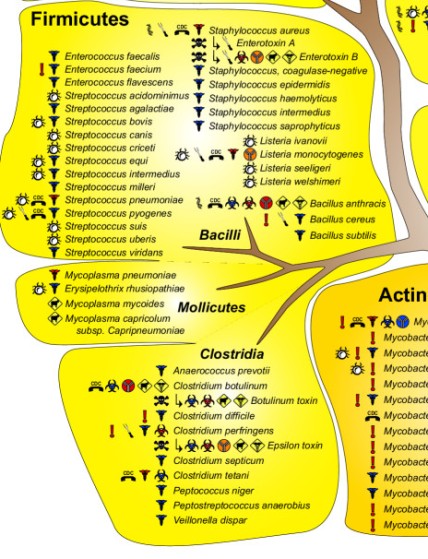Classification of Clostridium difficile
Clostridium difficile is more commonly referred to as a shortened version of its scientific name, C. diff. Clostridium is Greek for "kloster" meaning spindle. Spindle refers to the rod shape of the bacterium. Also, C. difficile has been quite difficult to grow in a laboratory setting, hence where it received the other half of its scientific name--"difficile" in Latin means "difficult".
|
Domain |
Bacteria |
![A micrograph of Gram-positive Clostridium difficile from a stool sample (From: Public Health Image Library [CDC] http://phil.cdc.gov/phil/home.asp)](bucolic/cdiff1.jpg)
|
|
Kingdom |
Eubacteria |
|
|
Phylum |
Firmicutes |
|
|
Class |
Clostridia |
|
|
Order |
Clostridiales |
|
|
Family |
Clostridiaceae |
|
|
Genus |
Clostridium |
|
|
Species |
Clostridium difficile |
From: (Public Domain) Centers for Disease Control and Prevention. 2009.
<URL:http://phil.cdc.gov/phil/home.asp>. Accessed 31 March 2009
Why does Clostridium difficile belong to these groups?
Domain- Bacteria
Bacteria are prokaryotic, unicellular organisms that contain peptidoglycan in their cell walls.
Kingdom- Eubacteria
Likewise, Eubacteria, the "true bacteria," are separate from the other domains and kingdoms because they contain peptidoglycan in their cell walls.
Phylum-Firmicutes
This phylum includes bacteria with a Gram-positive stain and a low G (guanine) and C (cytosine) content.
Class-Clostridia
The Clostridia are separate from other Firmicutes classes because they lack aerobic respiration and actually engage in anaerobic fermentation.
Order- Clostridiales
Members of the Clostridia class belong to one of three orders—Clostridiales, Halanaerobiales and Thermoanerobacteriales. The other two orders, halanaerobiales and thermoanerobacteriales, are very specific Clostridia that live in very specific environments, high salt areas and high temperature areas (like deep thermal vents and hot springs,) respectively. The rest of the Clostridia are “dumped” into the Clostridiales order; however, this order is not a natural grouping and, consequently, is not monophyletic. In the future, advanced research will most likely redefine this order.
Family-Clostridiaceae
Bacteria in this family are gram-positive, form endospores, are anaerobic, have a low guanine and cytosine content and share certain 16S rRNA gene sequences.
Genus- Clostridium
Members of the genus Clostridium are classified based on morphology, physiology, DNA relatedness, and rRNA gene sequence similarities. Members of the Clostridium genus are Gram-positive, form endospores, are anaerobic, and are unable to reduce sulfate to sulfide.
Species- Clostridium difficile
Species of Clostridium are divided based on
their sequences of genes coding for 16S rRNA. Species are also separated by
the production of toxic and antigenic proteins, their type of anaerobic
metabolism, the percentage of G +C, and also on the basis of nucleic acid
homologies. Clostridium difficile produces two
exotoxins, toxin A and toxin B, which can cause severe diarrhea and disease—Clostridium
difficile- associated disease (CDAD). C. difficile
generates ATP via amino acid fermentation.
Adapted from: Elsayed, S. and K. Zhang. 2004. Human infection caused by Clostridium hathewayi.
Emerging Infectious Disease 10: 1950-1952.
This phylogenetic tree represents the three classes, Bacilli, Mollicutes, and Clostridia, of the phylum Firmicutes. Clostridia bacteria lack aerobic respiration and actually generate their ATP via anaerobic fermentation. Clostridia also contain peptidoglycan in their cell walls. Bacilli are rod-shaped Firmicutes that engage in aerobic respiration and also have peptidoglycan in their cell walls. Mollicutes are a unique group of bacteria that actually lack peptidoglycan; however, they are phylogenetically related to Gram-positive bacteria.
C. difficile is located in the phylum Firmicutes and in the
Clostridia class. Other species in the Clostridia class are shown.
-------->
Cropped from (Public Domain): Ecker, D. J., S. Rangarajan, P. Willett, J. R. Wyatt, V. Samant, C. Massire, T. A. Hall, K. Hari, J.A.
McNeil, C. Buchen-Osmond and B. Budowle. 2005. The Microbial Rosetta Stone Database: A
compilation of global and emerging infectious microorganisms and bioterrorist threat agents. BioMed
Central Microbiology 5: 1471-2180.
Now that you know where C. difficile is classified amongst other organism, you should learn how C. difficile is able to grow, survive, reproduce, and move.

